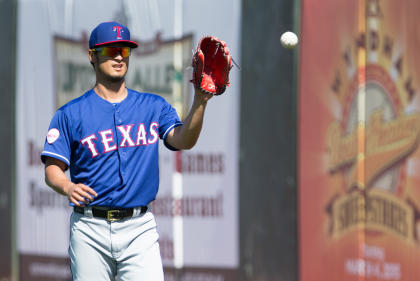Baseball's arm epidemic is getting worse, and Yu Darvish is just the latest

Earlier this week, the Japanese Orthopaedic Society revealed the results of a massive survey of elementary-age baseball players. More than 10,000 children were asked a series of questions about pain in their throwing arms, and the results were staggering, particularly for a country that prides itself on building strong arms through endless repetition.
Nearly 6,000 kids reported feeling pain in their throwing arms. Among pitchers, 49 percent said they experienced a shoulder or elbow injury. Not even 5 percent of those in pain bothered visiting an orthopedist, the specialist trained to treat such injuries. The report suggested wholesale changes in the Japanese baseball establishment.
Such criticism tends to find as much traction in Japan as worn-down sneakers on wet blacktop. What resonates there, particularly among the children, are the fortunes of the stars who leave Japan for Major League Baseball. Perhaps now, with Saturday’s news that Yu Darvish’s ulnar collateral ligament is damaged and almost assuredly will require Tommy John surgery, Japan will recognize the depth of the arm epidemic plaguing baseball.
It is no longer folly to call it that, not when the elbows of baseball’s best and brightest young pitchers continue to fail. The scary part, too, is that the scourge of the UCL knows no prejudice. American, Dominican, Venezuelan and even Japanese fall prey in almost equal proportions, which points to a fundamental failing of the modern game and the environment in which pitchers today grow.

This is a worldwide problem, and it’s only going to get worse.
And that frightens MLB, which last season started devoting more time and resources to spreading the word of the doctors who for years have warned of the coming onslaught of elbow injuries. MLB didn’t ignore the increasing number of Tommy John surgeries so much as it didn’t concern itself with them. Pitchers tended to return healthy from UCL reconstruction, and that was that.
Over the last five years, that truism has been tested time and again. A deluge of repeat surgeries hit, the latest Joel Hanrahan’s diagnosis this week that his Tommy John 22 months ago never took and he needed a revision. Among Hanrahan, Atlanta reliever Shae Simmons, Kansas City reliever Tim Collins and Cuban infielder Hector Olivera, damaged UCLs once again are at the forefront of spring-training news.
The Darvish diagnosis dwarfed them all, a gut punch similar to when Matt Harvey and Jose Fernandez and Stephen Strasburg needed Tommy John. Darvish is 28 years old, seemingly past the danger zone of the early to mid-20s that ensnared most of the pitchers whose UCLs tore last year, and yet his injury illustrates that nobody is immune.
While Darvish certainly threw more growing up than almost every American pitcher, his usage paled compared to those of Masahiro Tanaka, the New York Yankees ace trying to pitch through a partially torn UCL, and Daisuke Matsuzaka, whose legendary 300-pitch bullpen sessions predated the Tommy John surgery that for all intents and purposes ended his career in the major leagues. For a Japanese player, Darvish was considered a safe bet.
By now, we know that’s an oxymoron when it concerns pitchers. When you think it can’t get any worse, it does. For the Rangers, who follow an injury-plagued season by almost assuredly losing the one player they couldn’t afford to lose, and probably until May or June 2016. And for baseball, which keeps losing stars for a year and sits around waiting for more bad news after that, knowing that data shows the likeliest player to suffer an arm injury is one who has suffered a previous arm injury.
Modern baseball has been barreling toward this moment for the past 20 years, and it’s not going away anytime soon. All of the perils that harmed the current generation – overuse as children, max-effort delivery on every pitch, increasing velocity, poor training methods, moral hazard among adults tasked with handling kids – have, if anything, gotten worse. There won’t be a day when every pitcher wears a zipper scar on his elbow. But the ones who don’t will be the lucky few.
Darvish’s injury reinforces the susceptibility of every pitcher and is yet another sounding of the clarion call that goes ignored again and again. For baseball to slow down the prevalence necessitates a top-to-bottom overhaul of its development structure.

The league’s PitchSmart initiative is a good start. For now, that’s all it is. Because baseball needs buy-in from the lowest levels, from moms and dads, from coaches, from swaths of people who simply aren’t interested in listening to an authoritative body tell them how to handle their kid, no matter how rooted in science and logic the suggestions may be.
It’s not just here, either. In August, at the Space 11 Darvish Museum in Kobe, Japan, a man with a vested interest in baseball thought about the swelling rate of injuries in his country and wondered what would stop it.
“Who is to change this?” Farsad Darvish said. “I suppose only time can.”
Farsad is Yu Darvish’s father, and much as he tried to limit the amount his son threw as a child, he couldn’t deny what feels more and more like an inevitability. Whether it’s usage or mechanics or genetics, there’s a reason nearly 60 percent of boys’ elbows in Japan hurt after they threw, a reason Yu Darvish eventually will join the Tommy John club, a reason this keeps happening again and again.
Baseball is broken. Only time – and a sport-wide cultural change – can help fix it.

 Yahoo Sports
Yahoo Sports 
